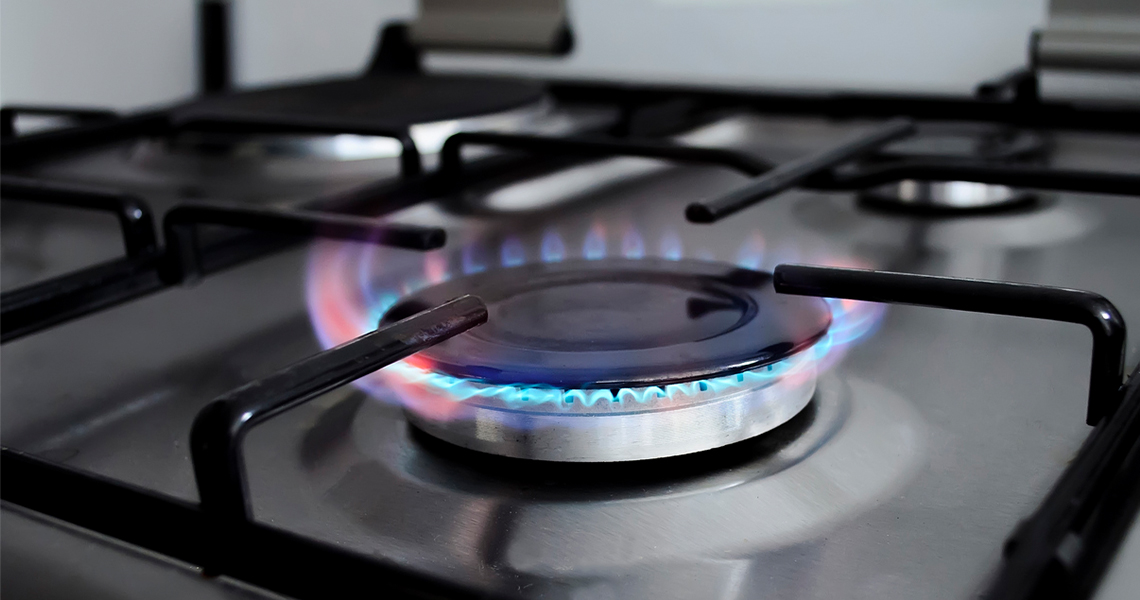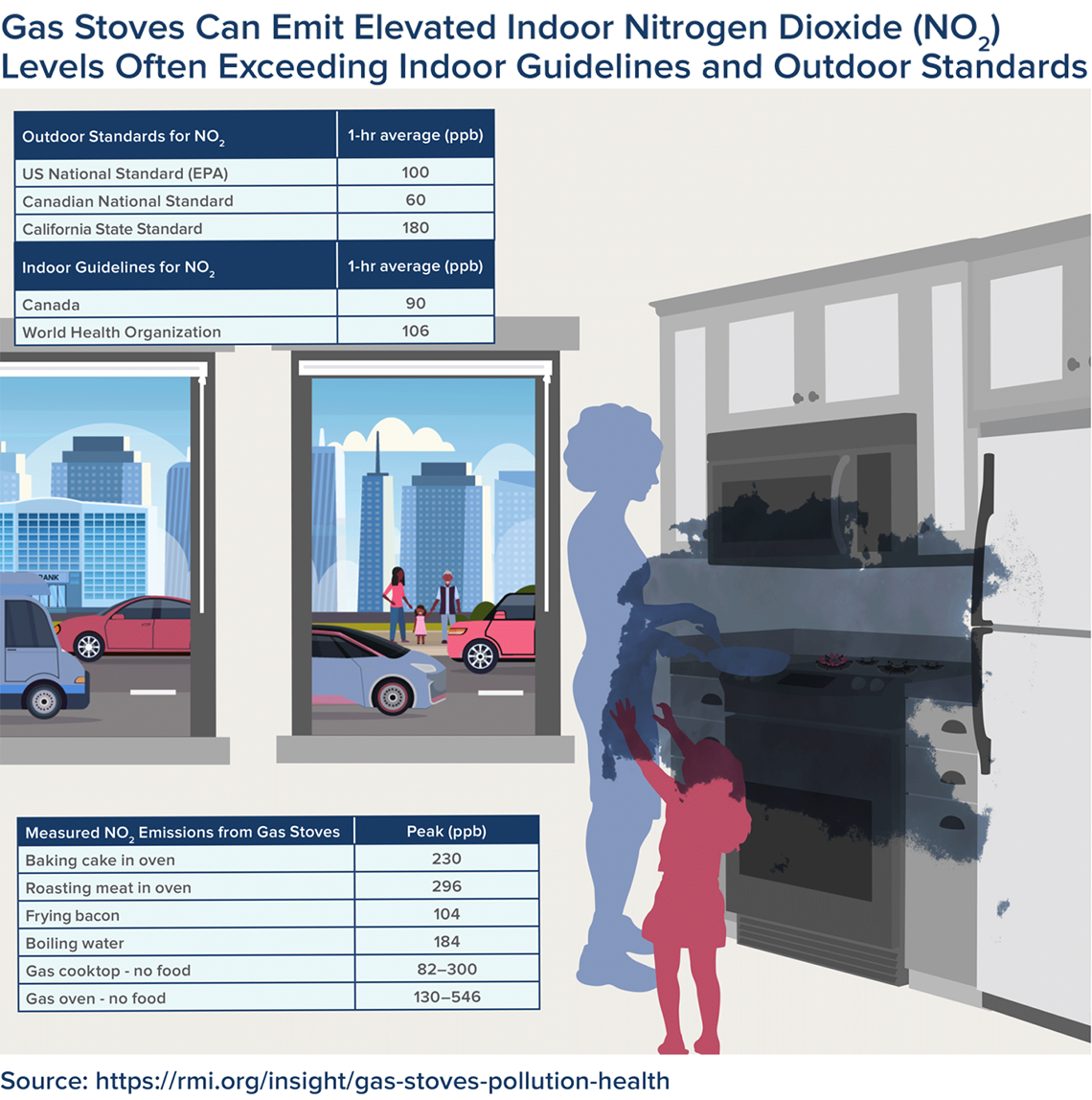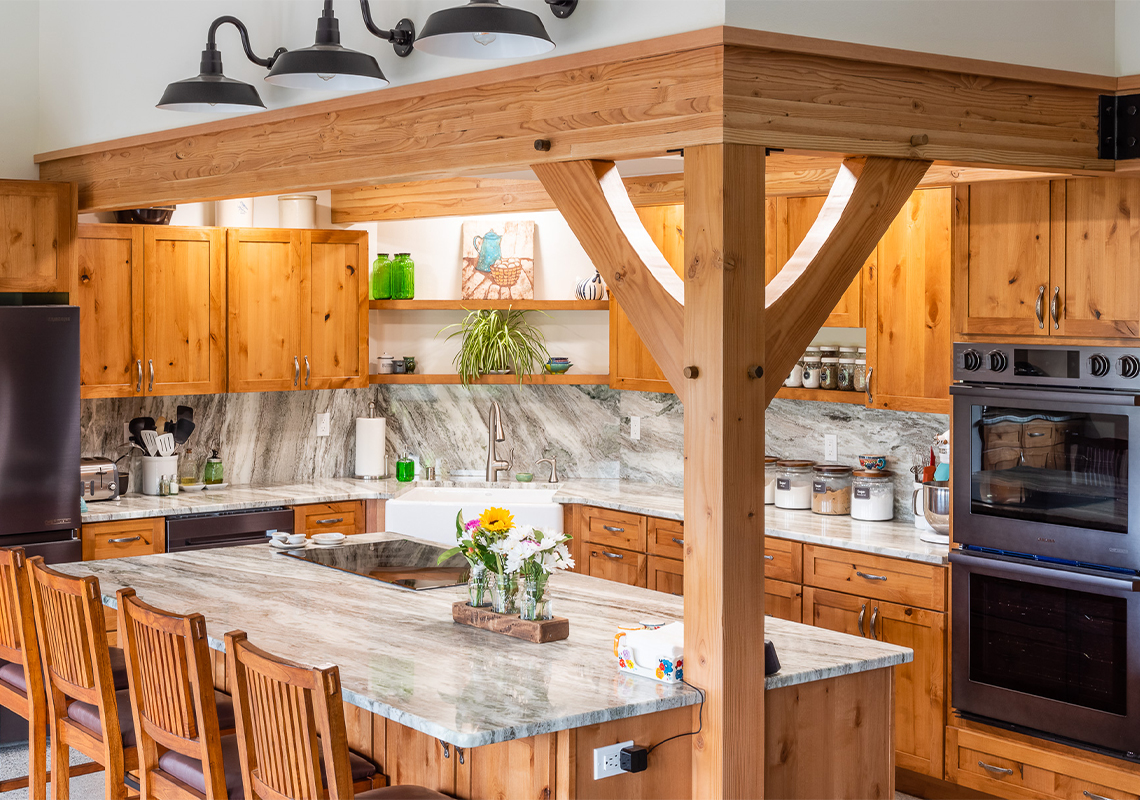With over 70% of homes in the most populous cities across the country relying on gas for cooking—compared to just 30%
of EU households—it’s clear that several decades of marketing worked. Now with the rise of social media, natural gas proponents have taken their campaigns directly to consumers online, microtargeting homeowners across social platforms to convince the American public that cooking with a gas flame is superior to using electric cook tops.
Just a few of the popular misconceptions in favor of natural gas stoves:
- "Cooking with natural gas is safe.”
- “Proper ventilation removes any unsafe combustion fumes.”
- “Restaurants and chefs require natural gas cooking for
precise temperature control.”
- “Natural gas ranges and cook tops are seen as a symbol of class and sophistication.”
- “Cooking with
natural gas costs so much less and it’s more efficient.”
- “Burning natural
gas for cooking is clean and natural.”

While natural gas is a cleaner cooking fuel than traditional biomass fuel sources (e.g., wood or coal), technological advancement with induction cooking enables us to move beyond less efficient, and more toxic indoor combustion cooking. Consumers are beginning to understand the risks and limitations of what used to be the star appliance in any modern kitchen, and misconceptions are beginning to unravel as more studies reveal how gas stoves contribute more indoor pollution, ambient heat, and greenhouse gas emissions than induction or electric stoves. Meanwhile, electric induction cooktops now offer sleeker, smarter, faster, and more precise cooking while also being safer, easier to clean, and free of natural gas price hikes.
Be like the Jetsons and cook with induction
Historically, the alternative to natural gas cooking was electric heated nichrome coil ranges and cooktops, either exposed coils or ceramic-glass-surface-covered coils. Conventional electric cooktops, like gas cooktops, use a heated coil burner where the radiant heat is conducted through the air and pan to cook your food. Many are familiar with the negative aspects that come with conventional electric coil burners, such as slow and imprecise thermal regulation during cooking, increased risk of surface burns, and arduous cleaning.
But electric induction ranges and cooktops are in a different class than those conventional electric appliances many of us grew up with. Under the ceramic glass surface of an induction cooktop, a coil of copper generates a magnetic field that triggers an electromagnetic reaction in the iron molecules in the cookware to heat only the pan (not the air) to cook your food. Newer induction models can be set to maintain specific temperatures and have been shown to shave off up to 50% of average cooking times—due to the rapid response of the electromagnetic cycle—thus using less energy than conventional gas and electric cooktops. Because induction appliances heat the pan and not the cook surface or air, they greatly reduce risk of burns, house fires, and difficult-to-clean burnt-on food. As a bonus, they will also keep your home cooler during warmer months.
Induction cooktops look sleek and maintain their clean appearance. They are the latest in cooking technology and come with a variety of smart features that will please and enhance any home cook’s culinary adventures.
However, even with the superior user experience of induction cooking, its adoption has been held back by messaging favoring natural gas. We’ll break down fact from fiction for the most common misconceptions in the market.
Misconception: “Cooking with natural gas is safe.”
Natural gas ranges and cooktops produce more indoor air pollution than most people realize. Gas burners emit a host of dangerous pollutants, including particulate matter, formaldehyde, carbon monoxide, and nitrogen oxides. Dr.
Shelly of the University of Colorado, Boulder’s Environmental Engineering
Program explains that when a stove burns natural gas—just as when a car burns gasoline—combustion oxidizes molecules in the air to create nitrogen oxides (NO2), which can make us sick. Nitrogen oxides, which are not regulated indoors, have been linked to an increased risk of heart attack, asthma, and other respiratory diseases.
Homes with gas cooking have anywhere between 50 and 400 percent higher concentrations of nitrogen dioxide than homes without, according to EPA
research. According to a study by the UCLA
Fielding School of Public Health, children in homes with gas stoves are 42% more likely to have asthma than children whose families use electric.

Disclaimer: For those using pacemakers, due to the electromagnetic interference it is recommended to keep a distance of at least two feet between the induction stovetop and your pacemaker. Please learn
more here.
Misconception: “Proper ventilation removes any unsafe
combustion fumes.”
To reduce NO2 emissions in your home, the EPA recommends using an exhaust fan above your gas stove that's vented to the outdoors, but there are currently no regulations requiring exhaust fans to vent outdoors. Many small apartments lack this form of ventilation due to the lack of regulations in the market. Low-income Americans, many of whom are renters, are involuntarily exposed to combustion byproducts that lower their indoor air quality and may worsen existing health disparities.
Many existing hoods and fans simply recirculate the air (and pollutants) rather than venting it outside. The performance and adequacy of
hoods varies widely, capturing anywhere between 15 and 98 percent of emissions depending on positioning and airflow. In addition, people who do have them often don’t use them, finding them noisy or distracting, or just forgetting. A 2014
study by the Lawrence Berkeley National Laboratory found that cooking with gas for one hour without ventilation adds up to 3,000 parts per billion of carbon monoxide to the air, raising indoor concentrations by up to 30 percent in the average home.
Regardless of the theoretical potential of hoods and other ventilation to keep the air clean, it’s clear that current practices leave millions exposed to unsafe indoor air pollution. To remedy that, standards for ventilation and hoods would have to be tightened, standardized and subjected to stricter enforcement.
Misconception: “Restaurants and chefs require natural gas
cooking for precise temperature control.”
Conventional electric coils are slow to respond to thermal changes and are too imprecise to maintain specific temperatures. This is one of the biggest reasons people embraced natural gas cooking: intense heat from the flame meant faster heating and cooling when the flame was removed. However, numerous induction appliances have taken it a step further and offer precise temperature control for rapid boiling and long slow simmers. Once the element is turned off or on the electromagnetic reaction halts or increases and cookware quickly reacts to desired temperature changes.
And who actually likes working in a hot kitchen? Induction burners produce no radiant heat into the surrounding air, so they are exceptional at maintaining a cooler room temperature. Take it from Chef Jon Kung: “Working all day in a hot [restaurant] kitchen can be exhausting. The fact that induction cooking produces very little waste heat was my main reason for making the switch.” The lack of open flame or hot electric coil provides a safer and cooler kitchen. Induction cooktops also have pan sensors, so they do not turn on when there is no pan present—a nice safety feature.
Misconception: “Gas ranges and cook tops are seen as a
symbol of class and sophistication.”
Gas ranges and cooktops—like granite countertops, farm sinks, and stainless-steel refrigerators—have been marketed as a symbol of class and sophistication and used as a popular selling point. However, induction cooking is fast becoming more popular—mainly because it makes all those routine cooking challenges disappear. Pasta water boils in 1–2 minutes. Burners don’t get hot, only the pan does. And all expended energy goes into the cooking, nowhere else. In addition, the convenience of a smooth-top electric range or cooktop that is easy to clean with no burned-on food, spills, indents, or crevices is hard to overstate. “I love the induction stove; it heats up really quick. The best part is it is so wipeable,” explains Carrie Trax, homeowner of TC
Legend Homes Everson Net Positive Home.

Misconception: “Cooking with gas costs so much less.”
While induction ranges and cooktops still claim a smaller portion of the overall market, they are becoming more affordable. Induction appliance prices start at $1,000, which is only a couple hundred dollars more than a mid-tier gas or electric freestanding range. Mid-tier models, such as those offered by Bosch,
cost around $3,500 and include additional features and higher-quality hardware. Top-of-the-line induction ranges like those from Thermador can climb in price to $5,000 and include even more high-end features and manufacturing quality. These sound like hefty price tags, but they are still nothing next to the price of some high-end gas-powered ranges.
If you are building a new home with gas appliances, you are locking in gas usage for another generation, potentially subjecting current and future residents to the volatility of natural gas price hikes. “All-electric new construction is hands-down more economic than mixed fuel construction,” says Stephanie Greene, senior principal at RMI, at a Pacific
Northwest Utility Dive brief. Greene explains that there is a limited supply of renewable natural gas across the nation and that should be reserved for the hardest-to-decarbonize sectors. "And so all-electric new construction would be a wonderful way to start ensuring that the system becomes more affordable for customers."
There’s a common misconception that you’ll have to throw out all your cookware to buy special induction cookware, and that’s almost certainly not true. Most stainless steel, all cast-iron, and many non-stick pans will work. If a magnet sticks to the bottom of a pot, it’s induction ready.
In a recent survey by the National
Kitchen and Bath Association, designers planning for a combination of separate cooktops and wall ovens on future projects identified induction as the single most preferred type of cooktop, beating out both gas and conventional electric.
Misconception: “Burning gas for cooking is clean and
natural.”
As the impacts of climate change intensify, the tide has begun to turn against the use of fossil fuels. Burning natural gas in commercial and residential buildings currently accounts for more than 10 percent of U.S. emissions. The gas line out from the back of your stove is connected to a production-and-supply system that leaks methane during drilling, fracking, processing, and transport.
President Biden's climate plan includes the goal of cutting the carbon footprint of buildings in half by 2035 through incentives to retrofit homes and businesses with electric appliances and furnaces. Biden’s plan also sets a goal of net-zero emissions across the economy by 2050. Achieving these goals, according to many studies, will require electrifying buildings, making appliances more efficient, and powering them mostly through emission-free grids.
Carbon emission concerns over gas appliances have prompted moves by 42 municipalities across the country to phase out gas in new buildings. California has passed aggressive standards, including a plan to reduce commercial and residential emissions to 60 percent of 1990 levels by 2030. Washington state lawmakers intend to end all use of natural gas by 2050, and many local jurisdictions in the Puget SouThe gas industry, including big oil companies with natural gas holdings, has made efforts to reduce emissions and implement stricter regulations in methane emissions. However, to avoid the worst consequences of climate change, scientists
recommend keeping most of the world's fossil fuels, including nearly half of the gas reserves, in the ground and out of our cooking.
Further Reading
How the Fossil Fuel Industry Convinced Americans to Love Gas Stoves. Mother Jones.
We need to talk about your gas stove, your health and climate change. NPR.
Gas Stoves: Health and Air Quality Impacts and Solutions. RMI.
Gas stoves can generate unsafe levels of indoor air pollution. Vox.
Performance Assessment of U.S. Residential Cooking Exhaust Hoods. ACS Publications.
If Induction Cooktops Are So Great, Why Does Hardly Anyone Use Them? New York Times Wirecutter.
As PNW utilities contemplate building decarbonization, affordability concerns linger. Utility Dive.